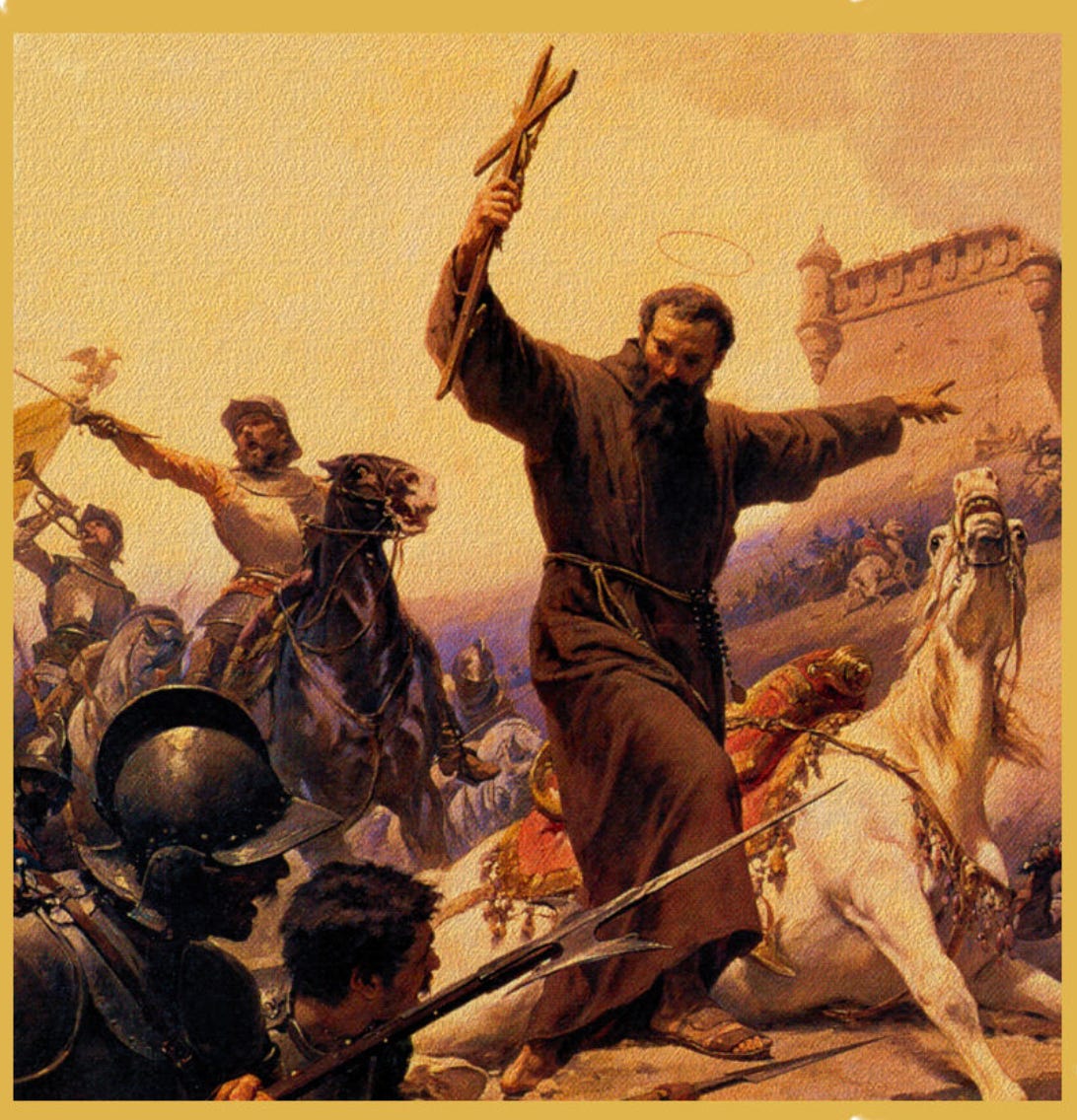Riding before them, armed with a Crucifix
21st July ~ Saint of the Day
ST LAURENCE OF BRINDISI (A.D. 1619)
(Transferred to July 21)
Cesare de Rossi was born at Brindisi in the kingdom of Naples in 1559, of a Venetian family of good standing. He was educated first by the Conventual Franciscans in his birthplace and then by his uncle in the college of St Mark at Venice. He made rapid progress, both in studies and in the spiritual life, and when he was sixteen received the Capuchin Franciscan habit at Verona, taking the name of Laurence. He made his philosophical and theological studies at the University of Padua, displaying a marvellous gift for languages: he learned Greek, Hebrew, German, Bohemian, French and Spanish, and had an extraordinary knowledge of the text of the Bible. While still a deacon he preached a Lenten course of sermons, and after his ordination preached with great fruit in Padua, Verona, Vicenza and other towns of northern Italy. In 1596 he went to fill the office of definitor general of his order in Rome, and was charged by Pope Clement VIII to work for the conversion of the Jews. In this he had considerable success, his knowledge of Hebrew being a valuable adjunct to his learning and holy life. He was sent with Bd Benedict of Urbino into Germany to establish the Capuchins there as a bulwark against Lutheranism; they began this work by nursing those sick of the plague, and before they left they had founded friaries at Prague, Vienna and Gorizia, which developed into the provinces of Bohemia, Austria and Styria. At the chapter of 1602 he was elected minister general of the Capuchins, and administered his charge with both vigour and charity, setting out at once on a visitation of the provinces; but when his term of office was up, in 1605, he refused to stand re-election; nor would he allow work to be kept for him to do.
While still vicar general Laurence had been sent by the emperor, Rudolf II, to enlist the help of the German princes against the Turks who were threatening the whole of Hungary. He was successful in his mission, an army was got together, and Laurence was appointed chaplain general of the forces. He even fulfilled in some respects the duties of chief-of-staff as well: before the battle of Szekes-Fehervar in 1601 the friar was consulted by the generals; he advised assault, gave a rousing address to the troops, and himself rode before the army—armed with a crucifix. The crushing defeat of the Turks was attributed on all hands to St Laurence. There is a story that on his way back from this campaign he stayed with his brethren at Gorizia, where our Lord appeared to them in choir and gave all holy communion with His own hand. Having spent some time preaching and reconciling heretics in Germany he was commissioned by the emperor to induce Philip III of Spain to join the Catholic League, and took the opportunity to found a house of Capuchins in Madrid. Then he was sent to Munich as nuncio of the Holy See at the court of Maximilian of Bavaria, head of the League; from here he administered two provinces of his order and continued his work of pacification and conversion. After settling two more royal quarrels he retired in 1618 to the friary at Caserta, hoping there to be free from exterior distractions, though he had the will and the grace never to allow his activities in secular affairs to get in the way of the principal business of self-sanctification. He frequently fell into ecstasy while saying Mass, and his personal devotion was the starting-point of all his achievements.
But princes and governors, however irreligious themselves, often value the service of truly religious men. The chief men of Naples came to Laurence and complained of the tyranny of the Spanish viceroy, the Duke of Osuna; they feared a rising of the people; would he go to the court of King Philip and put their case before him? The saint was still not very old, but he was worn out and he was ill; moreover, he predicted that if he went he would never return. He set out. When at length he arrived in Madrid the king was not there: he had gone to Lisbon. So Laurence followed him across Spain and Portugal in the heat of summer. He used all his eloquence and power of persuasion on behalf of the Neapolitans, and gained his point; the Duke of Osuna should be recalled.
Then Laurence returned to his lodging, and there, on his birthday, July 22, in the year 1619, he died. He was buried in the cemetery of the Poor Clares at Villafranca, and was beatified in 1783; when in the course of the process his writings were examined, it was recorded of them that “Indeed, he is fit to be included among the holy doctors of the Church”. These writings consist for the most part of sermons, but include also a commentary on the book of Genesis and some works against Luther; until recently but little of them had been printed. St Laurence of Brindisi was canonized in 1881.
From Butler’s Lives of the Saints



